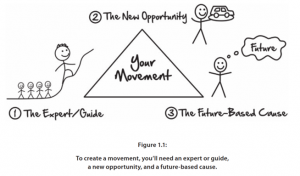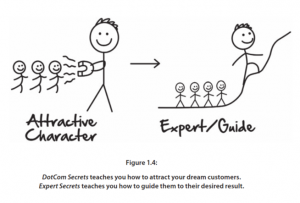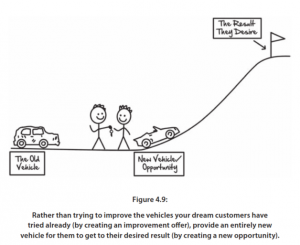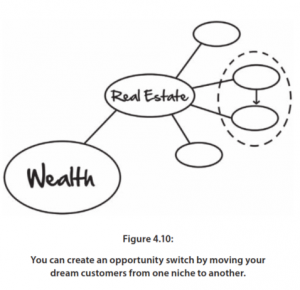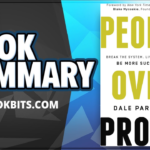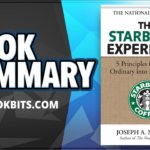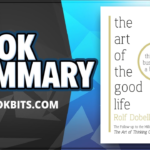STOP READING BY YOURSELF AND JOIN THE ‘BEST BOOK CLUB’ NOW HERE TO MEET AUTHORS AND NEW FRIENDS
STOP TRYING TO ACHIEVE YOUR GOALS BY YOURSELF AND BE COACHED TODAY HERE
DOWNLOAD THIS FREE PDF SUMMARY HERE
CHECK OUT THE FOLLOWING Book | Summaries | Course
YouTube |Spotify | Instagram | Facebook | Newsletter | Website
- Introduction: How to change the lives of the customers you’ve been called to serve
- There is a big difference between making a funnel and making a funnel that actually converts online visitors into lifelong customers.
- Get the people who come into your funnels to become raving fans.
- You are no longer going to look at your business as a product or a service, or even an offer, but instead you’ll look at it as a movement of people you’ve been called to serve.
- These frameworks are the key to attracting your dream customers and breaking their false beliefs so you can serve them at your highest levels.
- Your business is a calling. You’ve been called to serve a group of people with the products, services, and offers that you’ve created. People come into your funnels looking for a solution to their problems. By positioning yourself as an expert, and learning how to tell your story in a way that gets people to move, you are able to guide people through your value ladder, giving them the results they are looking for. This is how you change the lives of your customers, and this is how you grow a company.
- Business and entrepreneurship is a calling we receive.
- Ryan Moran once told me, “An entrepreneur is someone who takes personal responsibility for a problem that wasn’t their own.”
- While most of the world runs away from problems, especially the ones that are their own, we see a problem and feel called to step up and figure out a way to solve it. Every good business started this way, with someone feeling called to take on a problem that wasn’t their own, and that calling is special.
- Something you have experienced in your life started you on this path to create your business. It forced you to become more. You saw a problem, and then you had to read, study, and experiment with the things you learned in order to create the solutions you now offer your clients. By going through this refining process, you have become who you are today: an Most people then put their products up for sale, and don’t understand that their expertise is the key to actually selling the product. Your story-why you created this offer and started your movement-is what gets people to convert initially, and continue to stay with you over time.
- Your message has the ability to change someone’s life. The impact that the right message can have on someone at the right time in their life is immeasurable.
- As Sir Winston Churchill once said: To each there comes in their lifetime a special moment when they are figuratively tapped on the shoulder and offered the chance to do a very special thing, unique to them and fitted to their talents. What a tragedy if that moment finds them unprepared or unqualified for that which could have been their finest hour.
- SECTION ONE: CREATING YOUR MOVEMENT
- The product was just a tool, but creating a movement is what actually changed people.
- “They’re not selling software; they created a movement.”
- Three things in common that helped them build a mass movement:
- They each had a charismatic leader (or as we called it in DotCom Secrets, an Attractive Character)
- In this book we are going to take that role to the next level and call it an expert/guide.
- They each offered their audience a new opportunity.
- They then created a future-based cause that united the tribe of people they had attracted.
- The expert offers someone a new opportunity and then guides them to a result with a future-based cause.
- Becoming the Expert
- SECRET #1: FINDING YOUR VOICE
- Dan Kennedy, taught Russell that “we are all in a relationship business, not a product business.” He explained to Russell that people may come into your value ladder because of a product, but they stay because of their relationship with you, the Attractive Character.
- Use your personality to attract people to you.
- Lead them where they want to go. To become a leader or a guide, you have to grow into an expert.
- Jay Abraham once said, “People are silently begging to be led.”
- THE FIVE PHASES TO BECOME AN EXPERT
- Phase #1: The Dreamer (It Starts with a Spark)
- Tom Bilyeu listed five things to develop your passion or expertise:
- Go experiment with a ton of stuff.
- Identify things that speak your interest.
- Engage deeply with those things.
- As you engage, if it goes from interest to true fascination, go down the path of gaining mastery.
- Fascination + Mastery = Passion
- Every great movement has a leader, and this spark is the beginning of your leadership. It’s easy to assume that some people are just born leaders and others are not, but that’s not true. Leadership and how to become an expert is something that you can learn.
- Most have felt an internal pull to want to serve and help people. It’s almost like a voice inside them telling them they are destined for greatness. Yet at the same time, they have this other voice that consistently tells them they’re inadequate, that they’re not enough. Not smart enough, not focused enough, not thin enough, not experienced enough, not good enough…
- The strange thing is that often the more they do and the more people they help, the louder the voice of inadequacy becomes. Whether you’re just starting this journey or you’ve been at it for a while, know that the biggest hurdle you’re likely to face is being okay with calling yourself an expert.
- Phase #2: Taking on the Identity of the Reporter
- Your teachability index is how teachable you are at any given time. As a kid your index is high, but after you think you know something, if you’re like most people your index drops to zero and you stop learning. This is the worst possible thing that can happen to an expert.
- The next phase in your expert evolution is to start learning everything about your topic from multiple points of view. We need to keep your teachability index high so you are open to new ideas that you will need to create your own frameworks. The best way to do this is for your Attractive Character to take on the identity of the reporter and interview everyone you can get access to who is a few chapters ahead of where you are right now.
- The fastest way to turn your spark into a fire is to get around others who are on fire already.
- Going to live events.
- Starting your own “show” or podcast.
- THE SHIFT FROM GROWTH TO CONTRIBUTION
- Contribution is the key to continued growth.
- Phase #3: Building Your Own Frameworks
- STOP READING BY YOURSELF AND JOIN THE ‘BEST BOOK CLUB’ NOW HERE TO MEET AUTHORS AND NEW FRIENDSSTOP TRYING TO ACHIEVE YOUR GOALS BY YOURSELF AND BE COACHED TODAY HERE
DOWNLOAD THIS FREE PDF SUMMARY HERE
CHECK OUT THE FOLLOWING Book | Summaries | Course
YouTube |Spotify | Instagram | Facebook | Newsletter | Website
- It’s essential to remember that people buy products because they want certain results. My question for you would be: What is the framework that someone must follow to get that result? Your product is likely just a piece of that framework.
- Step #1 – Create your framework hypothesis
- Your job now as the expert is to become a framework creator. You do this by taking the information you’ve learned from tons of different sources and other people’s frameworks, looking at it, and organizing it into your own personal hypothesis for the perfect framework.
- During this step you are doing what Bruce Lee means when he said, “Research your own experience, absorb what is useful, reject what is useless, and add what is essentially your own.”
- Step #2 – Test your framework hypothesis on yourself (human guinea pig)
- Step #3 – Give your framework a proprietary name
- Phase #4: Work for Free
- Serving Your Future Dream Clients
- Garrett J. White once said: No matter what you do, in the beginning it’s going to suck, because you suck. But you’ll get better, and you’ll suck less. And as you keep doing this, eventually you’ll suck so little… you’ll actually be good.
- The next phase is all about testing your frameworks. Even if they have already worked for you, you need to test them and make sure that they work for other people too.
- Find a beta group of people you can test it with.
- The goal with this or any kind of business is not to lead with, “How can I sell my product?” Instead, you want to ask, “How can I serve people?”
- Phase #5: Becoming an Expert
- Once you’ve gone through the first four phases, you will be ready to start using your frameworks and leading people as an expert.
- The objection that I’m not certified, I can’t help people yet can easily be overcame by saying I’m really good at getting people results. My results are my certifications.
- You don’t have to be the most knowledgeable person in the world on your topic, you just have to be one chapter ahead of the people you’re helping.
- Who do you need to become as a leader?
- It starts with finding your voice. The secret to finding your voice is in sharing your message consistently for a long time.
- The majority of the people who had joined Russell’s highest-level mastermind groups and coaching programs had been podcast listeners first!
- Step #1 – Publish daily for at least a year.
- If you can publish every day for a year, you’ll never have to worry about money problems again. During the process, you will find your voice and your audience will have time to find you.
- “Ensure Long Enough to Get Noticed.”
- There is so much content being produced that we can’t possibly discover it all. So instead, we wait for the best content to float to the surface after time. If step one in building an audience is to create great content, step two is to endure long enough to get noticed.
- Step #2 – Document the journey.
- Gary Vaynerchuk talks about a concept he calls “Document, Don’t Create.”
- In very simple terms, “documenting” versus “creating” is what The Real World and Keeping up with the Kardashians are to Star Wars and
- You can ponder about the strategy behind every post and fabricate yourself into this “influential person”…. or you can just be yourself.
- Documenting your journey versus creating an image of yourself is the difference between saying “You should…” versus “My intuition says…” Get it? It changes everything. I believe that the people who are willing to discuss their journeys instead of trying to front themselves as the “next big thing” are going to win.
- Starting is the most important part and the biggest hurdle that most people are facing. They’re pondering and strategizing instead of making. They’re debating what’s going to happen when they haven’t even looked at what’s in front of them.
- “We get paid a lot to think for other people.”
- Step #3 – Testing your material.
- Step #4 – Learn to be prolific
- Definition for prolific: someone who has abundant inventiveness.
- Jay Abraham said, “If you truly believe that what you have is useful and valuable to your clients, then you have a moral obligation to try to serve them in every way possible.”
- I want you to start thinking about your niche. What do you teach, and where is it on the Prolific Index? Many times, people are either playing it safe with the mainstream, or they are way out in crazy land where there is no money. You need to find your sweet spot between the middle and crazy.
- Step # 5 – Master persuasion.
- “People will do anything for those who encourage their dreams, justify their failures, allay their fears, confirm their suspicions, and help them throw rocks at their enemies.”
- Step #6 – Care …. A lot
- Theodore Roosevelt said, “Nobody cares how much you know until they know how much you care.”
- One struggle most of us have as we try to serve our audience is the guilt sometimes associated with getting them to pay us. There are two reasons it’s essential to their success that they pay you.
- Those who pay, pay attention.
- Yes, those who pay, pay attention-and the more they pay, the closer attention they pay. You are doing your audience a huge disservice if you undervalue what you are selling.
- Second, the more success you have, the less time you will have.
- SECRET #2 TEACHING YOUR FRAMEWORKS
- “Your framework is your savior.”
- Your framework can become a post on Instagram, a video on YouTube, an episode on your podcast, a lead magnet, a chapter of your book, a course, a membership site, a coaching program, a mastermind group, or something else.
- Introduce the framework.
- Step # 1 – Share how you learned it or earned it.
- The first thing Russell does after he introduces the framework is explain how he either learned it (your knowledge) or earned it (through your experiences).
- Step # 2 – Share the strategy (the what you do)
- Perfect Webinar framework looks like:
- Step #1 – Grab Their Attention and Quickly Build Rapport
- Step #2 – Tell Your Origin Story about How You Earned or Learned Your New Opportunity
- Step #3 – Break and Rebuild Their False Belief Patterns with the Three Core Stories (Vehicle, Internal, and External)
- Step #4 – Use the Stack to Position the Offer Correctly
- Step #5 – Finish with Closing Techniques to Increase Close Rates
- Step #3- Teach the tactics (the how you do it)
- Section One, “Creating Your Movement,” is a framework. Here are the three steps (and strategy) of that framework:
- Step #1 : Becoming the Expert
- Step #2: Creating the New Opportunity
- Step #3: Giving Your People a Future-Based Cause
- That’s how we’re able to take a simple framework and teach it in a two-minute YouTube video (Level 1), a two-hour webinar (Level 2) or a two-day live event (Level 3). You’re still teaching the same framework, but you’re able to go deeper into the embedded frameworks when you have more time.
- Step #4 – Show them how it works for others
- From the first minute you start applying your framework to others and every day after you start sharing these frameworks, you need to be gathering the stories, case studies, testimonials, examples, and proof that your framework can get results for the people you are serving.
STOP READING BY YOURSELF AND JOIN THE ‘BEST BOOK CLUB’ NOW HERE TO MEET AUTHORS AND NEW FRIENDS
STOP TRYING TO ACHIEVE YOUR GOALS BY YOURSELF AND BE COACHED TODAY HERE
DOWNLOAD THIS FREE PDF SUMMARY HERE
CHECK OUT THE FOLLOWING Book | Summaries | Course
YouTube |Spotify | Instagram | Facebook | Newsletter | Website
- SECRET #3 – THE THREE CORE MARKETS OR DESIRES
- If you don’t know who you’re serving, anything you come up with is a guess, because you aren’t the one buying it. You don’t fill your own wallet. You need to figure out who you are going to serve first, and then you can create the offer(s) that they want.”
- The Three Core Markets/Desires
- There are three core markets or desires that every product is marketed through. The three desires (in no particular order) are health, wealth, and relationships. When people purchase a product or service, they’re hoping to get a certain result on one of these three areas of their lives.
- “If your product doesn’t fit into one of the three core desires, then your sales message at least must!”
- The Submarkets
- What are the other submarkets inside my core desire that people are using to try to get that desire met?
- What is the submarket that my product or service fits into?
- Question #1: Would people in this submarket be excited about the new opportunity/frameworks you will be presenting them?
- Question #2: Are the people in this market irrationally passionate?
- Question #3: Are these people willing and able to spend money on information?
- The Niches
- As businesses started to varve out their own submarkets, in a very similar way to what happened with the core markets, other sharks saw the opportunities as well. Within time, many of these blue oceans became bloody with competition.
- And that brings us to the market that we have inherited now. The core markets and the submarkets are red oceans, and now it’s out time to go one level deeper to what Russell calls the “niches.” Each niche is contained within a submarket, and it’s specific way to fulfill the desire of the submarket, which in turn fulfills the core desire.
- Inside each core market there are an unlimited number of niches.
- Core market > submarket > niche
- Health > nutrition > ketogenic diet
- Health > nutrition > paleo diet
- Health > nutrition > carnivore diet
- Wealth > real estate > short-selling houses
- Wealth > real estate > flipping houses
- Wealth > real estate > flipping house on eBay
- Relationships > parenting > dealing with toddlers
- Relationships > parenting > dealing with teenagers
- Relationships > parenting > dealing with marriage after kids leave
- What are all the niches inside the submarket you’ve chosen?
- Creating your own category (and becoming the category king)
- What new category can you create and become its category king?
- Market Selection and positioning
- If you have a correct market positioning, even if you have C or D level funnels and sales skills, it’s almost impossible to fail.
- Market selection secrets by Steve J Larsen
- The market is a location not a person
- A market is a place for buyers and sellers to meet and exchange goods and services.
- Your job is to first know who your dream customer is and then find out where they’re already going to exchange money for products or services (online or offline). Clarity on who your dream customer is and where they already go to buy is a major milestone and shortcut to creating effective marketing for your business.
- So the question is not “Who is your market?” Rather, the question is “Where is your market, and who is your dream customer who’s already going there?”
- Fishing in the red oceans: Every red ocean is a marketplace full of people coming together looking for solutions to a certain problem. If you are offering a new way for people to get that result, doesn’t it make sense to go fishing in these red oceans and pull these customers into your new category, your blue oceans?
- There are three core groups of people in each marketplace, and we are only going to target one of them.
- The first group is “the Diehard.” The Diehard is such a believer in the current product they use that the logo may as well be tattooed on their foreheads.
- When you’re choosing a market to serve, do not try to sell to the Diehards in that market. It’s futile and expensive. They’re so in love with the product they use that they may not know of many other options but they’d like to fight you anyway.
- The next group is “the Satisfied.” The Satisfied uses the product they bought but isn’t love with it like a Diehard. They’ve had enough success with the product to justify keeping it around, but the pain of switching to a new product can seem bigger than any discomfort they may be experiencing with their current product.
- The last group, and the one we focus on the most, is “the Frustrated.’ The Frustrated also use the product they bought, but they hate it. What was once an exciting purchase has now become so frustrating that they’re eager for the next product. They’re actively seeking a better product that can fit their desires. They have the shortest sales cycle and are often looking for reasons to give you money before you’ve even finished your sales script.
- If you decide ahead of time to sell only to the Frustrate in your market, you’ll have a much more enjoyable business and customer experience.
- Competitive or complementary: The offers you create will either compete with or complement the things that are already being offered in the marketplace.
- Market positioning is how people fit you into what they already know.
- Products that don’t make it are usually still great products. That’s not the problem. The problem is that business owners often have no idea who they’re selling to, where people are already buying from, and what kind of market positioning to use. Choosing a dream customer, selecting a market, and developing your market positioning will get you far more of a foundation.
- As Joe Polish said, “There’s no relationship between being good and getting paid. However, there’s a huge relationship between being good at marketing and getting paid.”
- SECRET #4: THE NEW OPPORTUNITY
- In The True Believer, which is one of the best books on how mass movements are created, author Eric Hoffer writes, “The practical organization offers opportunities for self-advancement… [A] mass movement…appeals not to those intent of bolstering and advancing a cherished self, but to those who crave to be rid of an unwanted self.”
- Our goal is not to fix what’s not working. Our goal is to replace what’s not working with something altogether different.
- When you create your own category and offer your followers a new opportunity, this gives you a chance to become the category king and have the biggest impact on people’s lives.
- “[Your customers] must be wholly ignorant of the difficulties involved in their vast undertaking. Experience is a handicap.”
- Dan Kennedy once told Russell, “If you can’t be the number one lowest-price leader in your market, there is no strategic advantage of being the second lowest price leader in town, but there is a huge strategic advantage of being the most expensive.”
- Status: The only thing that causes people to move (or not move)
- When someone is presented with an opportunity, their subconscious mind is working on the answer to this question: Is this thing I’m considering going to increase my status or decrease it?
- Almost every decision you’ve ever made was based on this one subconscious question: Is this thing I’m considering going to increase my status or decrease it?
- What stops people from taking that new opportunity? Fear of decreased status. The sale-killing thought is: What if I try this and it decreases my status? I will feel stupid. There’s this balancing act going on in our brains all the time. We’re balancing hope of increased status against fear of decreased status.
- Your job as the expert is to load up the elevated-status side of the scale and decrease the risk of failure. You can do that by creating an amazing offer and minimizing risk with things like money-back guarantees, risk reversals, and done-for-you options. The key to making a sale is 100 percent tied to this concept of status.
- As much as we may hate to admit it, we are slaves to what we believe other people will think about us.
- Why people crave new opportunities
- New discovery
- No pain of disconnect
- Dream replacement
- Greener pastures
- Step #1: What is the result your dream customers are trying to achieve?
- To be able to create your new opportunity, you have to understand at a very deep level what your dream customers really want.
- Step #2: What is the “vehicle” they are currently using to try to get that result?
- Consumers know the result they want, and they’ve tried a dozen other vehicles to try to get that result. They aren’t coming to you because they aren’t trying; they’re coming to you because the current vehicle isn’t getting them to their destination.
- Step #3 – The Opportunity Switch
- Step #4 – The Opportunity Stack
- Look at the result your dream customers desire and the new opportunity you have offered them, then package that opportunity in different ways to help them reach their desire.
- SECRET #5 – MORE MONEY FOR THE SAME FRAMEWORK
- People will spend more money for the exact same content (or framework) packaged in a different way.
- Create information products like books, courses, seminars, mastermind groups, and coaching programs.
- Mainly for Authors, speakers, coaches, and consultants
- It’s essential to create frameworks and wrap them around your core offers to make them a truly new opportunity.
- Expert Business #1 – Selling information products
- It involves taking the frameworks you’ve learned and packaging them into information products, coaching, and consulting.
- Being an expert and selling information products is the greatest start-up in the world. You don’t need venture or start-up capital, just a passion for what you’re teaching and a willingness to learn how to tell stories in a way that will get others excited about it.
- Expert Business #2 – Leveraging information products as fuel
- Your frameworks can either be turned into information or tools.
- Step #1: How to increase the value of your frameworks
- The simplest way to increase the perceived value of your framework is to change the experience of how someone consumes it. That usually happens by moving things from one form to another: Written word—-Audio, Audio—-Video, Video—-Live experiences
- The other way to increase the value of your frameworks is by changing how you fulfill on the framework. The three different ways that you can fulfill on a framework are:
- Do it yourself (Give them the framework and they implement it on their own)
- Do it with you (work with them to implement the framework)
- Do it for you (You implement the framework for them)
- While there could be hundreds of ways to package your frameworks, I’ll share the eight most popular ways that are used by experts in almost every industry.
- Pre-funnel content (free)
- Lead magnet (free)
- You can teach one of your frameworks in a short video and use that as a lead magnet in exchange for someone’s email address.
- Book (free + shipping)
- The negative thing with a book is that it’s the hardest thing to create and sell for the least amount of money, but its perceived value and ability to position you in your market as an expert is one of the highest ways you can package your frameworks.
- Membership site ($10-$100 per month)
- Online course ($100-$1,000)
- Seminar or workshop ($500-$5,000)
- Mastermind ($10,000-$100,000)
- One-on-one ($10,000+)
- Did you notice that even though the price changes for each way you package your frameworks, you’re not necessarily teaching new frameworks at each level? You are changing the experience of how people consume and implement those frameworks, and the value goes up at each level of service. If you look at most people’s value ladders, they’re simply changing how the frameworks are delivered.
- Step #2: How to create even more value by turning your frameworks into tools
- Create a shortcut to success for your customers by providing done-for-you tools from your framework.
- Software
- Supplements
- Physical products
- By-products
- Information Products/Services
- Remember, how much money your business makes is in direct relationship to how simple the process is for your dream customers to achieve their result. Creating done-for-you tools to give your customers a shortcut to success is one way to simplify that process.
- Step # 3: Turning your frameworks into an “Offer” with the Stack Slide
- Hook, Story, Offer
- It’s so important to de-commoditize your business, not just selling a product like most companies, but to make it something unique by turning it into an actual offer.
- The goal of an offer in its simplest form is to: Increase the perceived value of what is being sold.
- Make the thing being sold unique to you and available only within the special offer.
- The simplest way to turn your product into an offer, increase the perceived value of that offer, and make it a true new opportunity is to wrap your product or service inside your frameworks.
- Physical product or service: If you are selling a physical product or a service, that would be your core product, so your core frameworks could be taught in whatever modality that matches how much you want to charge for the offer.
- Information product or event: If the core product that you are selling is a course or event, the core product and the core framework will likely be the same thing.
- Next, I need to figure out other things I can add to the Stack to increase the perceived value even more.
- Written word: Should we write a book or an e-book?
- Audio: Should we make an audio program?
- Video: Should we make a membership site? Would it be better to make an online course?
- Live experiences: Should we create a seminar or workshop, or would this work better as a mastermind group or one-on-one?
- There are three reasons why people don’t buy from you.
- Make things inside my Stack that will help break those three core false beliefs.
- False Belief #1 – I don’t believe this vehicle (your new opportunity) is the right vehicle for me.
- False Belief #2 – I believe this is the right vehicle for some people, but I don’t think that I could be successful with it.
- False Belief # 3 – I believe that I could have success, but I have an external force holding me back from success.
- Every item on the Stack Slide has a value attached to it. The goal is to show that you’re giving 10 times as much value as you’re asking for in price. So if you’re selling a $97 product, you want the Stack Slide to add up to at least $997, preferably more. If you’re selling a product for $997, then the value needs to be at least $9,997.
- Learning how to create offers and build Stack Slides is one of the most important things you can learn to do in this business.
- SECRET#6 THE FUTURE-BASED CAUSE
- In Proverbs 29:18 it says, “Where there is no vision, the people perish.” Our job as an expert and guide for our audience is to help cast a vision for what is possible and bring our people to higher ground, to move them from where they are to where they want to be. The last step in creating your movement (after becoming the expert and creating a new opportunity) is creating a future-based cause. For every political, social, or religious movement throughout history, the charismatic leader paints a picture of the future they are trying to create and what life will be like when they get there.
- In his book The True Believer, Eric Hoffer writes, “Fear of the future causes us to lean against and cling to the present, while faith in the future renders us perceptive to change.”
- Step #1: Launch your “platform” to be your dream customer’s guide to the result
- All winning presidential campaigns were won with a new opportunity or a future-based cause; the losing campaigns featured improvement slogans.
- “You are only one sales letter away from striking it rich.”
- You’re just one funnel away……
- Exercise – To create your platform, I want you to imagine that you’re running for president of your movement. Think about what slogan would be great for your campaign. What do your people really want? Where do they want to go? How can you capture that in a simple calling you could put on a campaign sign?
- Step # 2: Give them an identity shift
- When you give your customers a new identity, they will become your true fans.
- Remember what Jay Abraham said, “If you truly believe that what you have is useful and valuable to your clients, then you have a moral obligation to try to serve them in every way possible.”
- It’s easy to sell someone something once, but to get them to buy from you over and over again (and be excited while doing it) you have to shift their identity.
- Tribe identity
- The first step to the identity shift is to create a name for your tribe that will make them want to belong.
- What’s your tribe called?
- Personal identity – The “I am” statement: For customers to be able to self-identity with your movement, they need to have an “I am” statement that quickly describes who they are. An “I am” statement is very similar to the tribe identity, but it’s giving customers the ability to self-identity with the tribe.
- To get people to identify with your movement, come up with something simple that you can put on a T-shirt your members could wear that would make them identity with your movement. Think “I’m a ……………….” Or “I…………….”
- Create a “Title of Liberty” or manifesto.
- To inspire your tribe, create a Title of Liberty, or manifesto, that will rally them to your cause.
- Your tribe needs a Title of Liberty that they can look to as motivation and a reminder about why they are trying to change. Something they can look at when they’re feeling doubtful—a rallying call. Something that will help them know who you are, remind them who they are, and refocus them on where you are going together.
- Funnel Hackers manifesto
- Funnel Hackers are entrepreneurs and business owners who are passionate about getting their messages, products, and services out to the world so they can change their dream customer’s lives.
- By turning our manifestos into a background image for our tribe’s phones, we’re able to constantly remind our dream customers of the new identity they’ve taken on.
- Step #3: Create milestone awards that pull people toward the result (Journey of achievement)
- Step #4: Unite with a social mission (Journey of transformation)
STOP READING BY YOURSELF AND JOIN THE ‘BEST BOOK CLUB’ NOW HERE TO MEET AUTHORS AND NEW FRIENDS
STOP TRYING TO ACHIEVE YOUR GOALS BY YOURSELF AND BE COACHED TODAY HERE
DOWNLOAD THIS FREE PDF SUMMARY HERE
CHECK OUT THE FOLLOWING Book | Summaries | Course
YouTube |Spotify | Instagram | Facebook | Newsletter | Website



